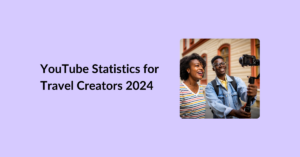As video editors, we learn a lot from our clients. Some clients share a detailed brief about what they want for every single video, while some discover their preferences as we edit their videos for them. They tell us whether they want more of a certain element or would like it a bit toned down.
It teaches us a lot about successful video marketing. But here’s our key takeaway:
The best videos have a very specific key message and arresting visual appeal.
Not sure what that means? It’s not your fault.
The statement above is incomplete without practical demonstration. So below, we’ve shared some iconic video marketing examples, along with useful tips for developing a successful video marketing strategy.
Table of Contents
Quick Takeaways
Step-by-Step Guide to Video Marketing Strategy
- Identify your target audience
- Identify topics of your audience’s interest
- Set up goals for the entire plan (and for each video)
- Pick a social channel (relevant to your audience)
- Set up a budget and timeline for your video marketing plan
- Arrange a strong skilled team of video makers and video editors to execute the plan
- Learn from published projects and improve
Key Metrics You Can Assess
- View count/Impressions
- Play rate
- Click Through Rate
- Conversion rate
- Completion rate
- Bounce rate
- Time on page
- Social comments and shares
What You Will Need
- A good camera (any phone with 12 MP or more will do)
- Market research
- Ideas, script, and plan
- A team (comprising a content creator, video maker, video editor, and social media manager)
Successful Video Marketing Examples
#1. Slack
As a cloud-based team collaboration tool, Slack’s biggest challenge was to communicate the functionality of Slack’s features with its target audience.
Slack has a lot of features. And the users require a bit of guidance to get the hang of it.
So, their video marketing strategy mainly comprises the following:
- Explainer videos
- How-to Tutorials
They capture their target market’s attention using relatable scenarios. Check out this video:
This viral video got millions of videos. It basically mocks The Office but with Slack solutions.
Notice how Slack has identified its target market’s pain points, highlighted them in the video, and offered solutions. Plus, they spent a good budget on the script, actors, and video production. The feature pop-ups and transitions you see couldn’t have been possible without a professional editor.
Here’s another example to help you understand how Slack is winning at video marketing in the SaaS industry.
Slack’s take on introducing their software:
Rocket.Chat’s take on introducing their software:
Rocket.Chat is Slack’s competitor. But unfortunately, their video is about what is Rocket. Chat is not directed towards their users.
It’s not relatable or interesting. It is only a narration of the features. They don’t demonstrate the functionality comprehensively. Plus, they could have improved the visual appeal to make it easier for the viewer to sit through the five minutes. But they did not pay attention to it. Bad move.
#2. GoPro
GoPro is an American technology company that manufactures the best compact action cameras. Moreover, the company is also known well in the video marketing world. They’ve nailed it!
GoPro’s primary aim is to build a strong community of its customers. They already have a physical product and active physical marketing. They also have a stable clientele.
So, their primary business goal online is to strengthen their customer retention and widen their customer base. To achieve this, GoPro focuses on the following types of videos:
- User-generated videos
- Event recap videos
The company basically uses video content generated by its customers to its benefit. It saves video production costs and helps them achieve their goal much more easily.
Check this out:
In all honesty, GoPro has been very innovative and lucky with its video marketing strategy. But the key aspect of learning here is that you can derive a lot of your video marketing ideas and content from your existing clients.
Here’s how:
- Turn any piece of content they produce that’s relevant to your product into a video. Let’s suppose you’ve got a post-designing tool, and they create a post from your tool. You can do a video about the best designs made using your tool.
- You can use their feedback to generate video content ideas. (Just by the way. Here’s a list of 20 engaging YouTube ideas)
· Ask for their reviews or record testimonial videos.
#3. Buzzfeed Tasty
Video Marketing strategies aren’t only meant to scale a product-based business’ revenue. Video Marketing strategy can be an independent source of income too, especially if you’re a content producer.
Buzzfeed Tasty videos establish our confidence in the very fact. If you’re on Facebook, Instagram, or YouTube, there’s a high chance you’ve seen one of Buzzfeed Tasty’s videos.
Here’s an example:
Choice of colors, video format, social channels, and video editing has a lot to do with the success of Buzzfeed Tasty videos. If these videos were longer or did not feature such smooth transitions, there’s a high chance these videos would have failed.
But Buzzfeed Tasty aimed to produce short-form engaging content in the food niche to entertain and educate users as they scroll through their feeds. To achieve this, they required a hook (the video title), captivating music, catchy colors, and appealing frame transitions.
Currently, Tasty videos generate huge revenue for Buzzfeed. Plus, now that they have a growing audience, they’ve expanded to long-form content as well.
How to develop a video marketing strategy?
In all honesty, video marketing strategy looks different for every single business out there. For some frequency of posts and impressions matter most. And for some conversion rates matter more.
It all comes down to your intent or the key message you wish to deliver. So, whether you’re a video creator, business owner, or video marketer, we ask you to determine the following:
- What do you want to communicate/solve?
- What is location, language, and age of your target audience?
- Which social channel does your target audience prefer the most?
Now, use this information to:
- Decide a video format
- Determine the vibe of your video (colors, fonts, music, etc.)
- Determine the length of your video (as per attention span)
- Pick a social channel
Answering all of these will help you come up with a specific intent, such as communicating the features and functionality of my productivity tool with office teams.
This specific intent is your plan. It is the key message. Divide this foundational plan into little actionable steps over a timeline. You can call this a strategy.
But know that you cannot implement this strategy alone. Video creation is a creative and demanding process. If you set out to do it on your own, you’ll probably take weeks to come up with something presentable.
Remember, we are not talking about TikTok videos here. We are talking about proper videos that can bring you business, such as explainer videos, tutorials, testimonial videos, etc.
So, you need to come up with something visually appealing. A lot of super useful but hardly appealing videos have gone to waste, simply because they were not appealing enough.
Check this out:
Ouch. Brilliant idea. Poor execution.
The company could have hired better actors or at least a professional video editor to save their marketing video from failing so badly.
To avoid the same fate, it’s best you hire professional video creators and video editors to maximize your chances of success. Each video will be a significant investment in terms of effort and resources.
Plus, professional video creators and video editors have a better idea about how to get attention on different social media platforms. This, in turn, minimizes risks.
Suggested Read: Learn How to Hire Video Editor
Bottom Line
If you’re only beginning your journey, the feedback may not be encouraging in the early days. In this case, we ask you to individually share the video with 2-3 of your existing customers.
Ask for their opinion. Use the feedback to come up with your next video. Remember, trial and error teaches wonders.
The detailed briefs we receive are not a product of some insider knowledge or research work. They always come from experience.
All our clients that provide a detailed brief are already past the trial-and-error stage and have found what excites their target audience.
Another point to learn here:
You can leave editing to professional video editors. You can leave the video creation part to professional video makers. But you cannot leave the experimentation phase to anyone else. It has to come from you.
So, good luck with the journey! Let us know how it goes in the comments below.




